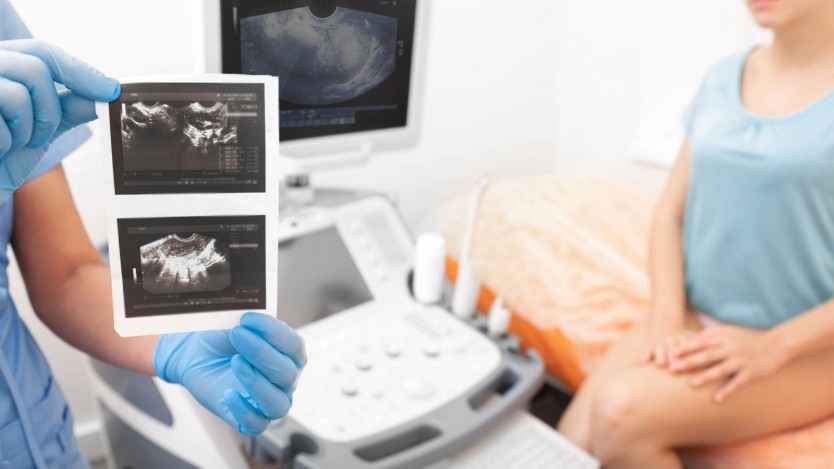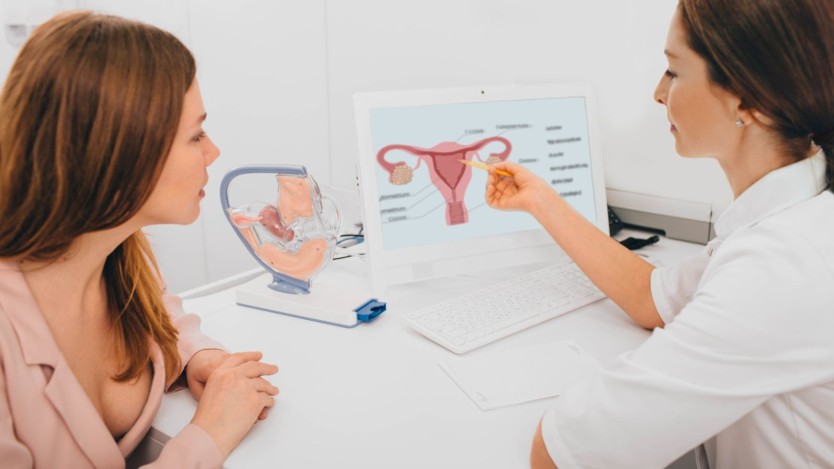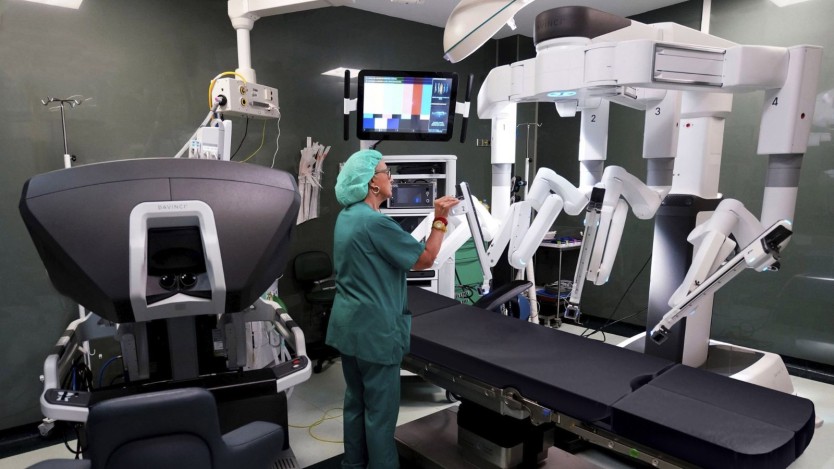Types of surgery to remove the uterus

- What does uterus removal surgery consist of?
- Abdominal hysterectomy
- Vaginal hysterectomy
- Laparoscopic hysterectomy
- Robotic hysterectomy
- Uterus removal surgery cost
- Request a free surgical assessment consultation
What does uterus removal surgery consist of?
- Womb removal surgery, or hysterectomy, is an operation in which the uterus is removed due to an associated pathology.
- The hysterectomy will be subtotal, total or radical depending on the amount of tissue removed and, depending on the surgical technique used, it will be abdominal, vaginal, laparoscopic or robotic surgery.
- Each of the techniques is indicated for specific cases, with the associated pathology and the size of the uterus being key factors in determining one technique or another.
The surgical intervention to remove the womb, also known as hysterectomy, is a surgical procedure in which all or part of the uterus, including nearby structures and tissues, is removed.

Do you need hysterectomy surgery?
Request a free and immediate appointment with our specialists in Gynaecology
There are various approaches, depending on the portion of the uterus to be removed and/or some of its appendages or components. However, in any type of hysterectomy, as well as its surgical technique, the aim is to improve the patient's quality of life and eliminate the likelihood of the pathology worsening.

Normally, these pathologies are usually benign in nature, as in the case of uterine myomatosis, localised endometriosis or abnormal uterine haemorrhage. However, there are cases in which the pathology may involve a malignant condition, as in the case of womb cancer.
As its name suggests, this intervention consists of the removal of the womb, i.e. the uterus, due to a series of diseases associated with it. Depending on where the condition is located or the extent of the same, the hysterectomy will be total, partial or radical.
Each consists of the following:
- Partial hysterectomy. This surgery is also known as a subtotal hysterectomy and involves the removal of the body of the uterus, leaving the cervix intact.
- Total hysterectomy. In this case, the entire womb is removed, i.e. both the body of the uterus and the cervix.
- Radical hysterectomy. Radical surgery is performed when it is necessary to remove the entire uterus, ovaries and fallopian tubes, surrounding tissue, lymph nodes and omentum.
- Total hysterectomy with double adnexectomy. In cases where a total hysterectomy is performed but, in addition, it is necessary to remove the fallopian tubes and the two ovaries.
Depending on the amount of tissue removed, the womb removal surgery will be subtotal, total or radical.
The womb or uterus is an organ of the female reproductive system between the bladder and the rectum. It is in the womb that the fertilised egg is implanted, i.e. the place where pregnancy takes place. Therefore, a woman who undergoes a hysterectomy assumes that she will not be able to become pregnant after the operation.
Abdominal hysterectomy
In this type of surgery, the womb is removed through an incision in the abdomen. With this surgery, the abdominal and pelvic cavity is accessed by dissecting each of the layers of the abdomen from the outside in. Thus, depending on where the condition is, or how far it has reached, the uterus and its adjacent parts such as the cervix, ovaries, fallopian tubes, etc. will be removed.
Uterus removal surgery is the most frequent surgical intervention in Spain and between 60-70% is performed via the abdominal route.
As with the other techniques, hysterectomy via the abdominal route requires a preoperative stage to determine that the patient is suitable for this surgery and to rule out the risks involved.

In general, abdominal hysterectomy is recommended for women who for medical reasons are not suitable for other types of surgery. This usually occurs in cases of an enlarged uterus with fibroids, endometriosis that has spread to the abdomen and ovaries, or pelvic inflammatory disease, etc.
Abdominal hysterectomy is performed under general anaesthesia and lasts 60 - 80 minutes.
The surgical technique of abdominal hysterectomy involves the following steps:
- The surgeon makes an incision in the abdomen to access the abdominal cavity.
- He then places a retractor to keep the incision open and to check the organs of the pelvic cavity.
- Once inside, the uterus is located and secured with two forceps for better visualisation of the elements that nourish it. In this way, the round ligament is sutured, avoiding the section of the ureter.
- The bladder is located and separated from the uterus by dissection.
- In the same way, the cervix is located and sectioned.
- The surgeon then removes the womb, closes the cervix and checks that the other structures are in good condition.
- Finally, a saline solution is administered to eliminate any bleeding that may have occurred and the cavities are closed.
In the following link you can find more detailed information about the abdominal hysterectomy operation and you can also check if Operarme collaborates with a Hospital in your city to perform the uterus removal surgery, via the abdominal route.

Do you need hysterectomy surgery?
Request a free and immediate appointment with our specialists in Gynaecology
Vaginal hysterectomy
Vaginal hysterectomy consists of removing the body of the uterus and/or any of its appendages through an incision in the dome or upper portion of the vagina.
In some cases, part of the surgery may be laparoscopically assisted, whereby the surgeon inserts the instrument through incisions in the abdomen and removes the uterus through the vaginal canal.
The surgical technique of vaginal hysterectomy involves the following steps:
- The surgeon makes a paracervical incision at the top of the vagina. In this way, the bladder, the ureters and the ligaments that join them to the womb can be located for removal.
- The recto vaginal space is then accessed through a paracervical incision posterior to the vagina, so that it joins the anterior one.
- The fibres that hold the uterus and vagina in place are sectioned to free the uterus.
- The uterine ligaments are dissected and the ovarian appendages, fallopian tubes, arteries, etc. are located.
- The surgeon clamps the uterine vessels and removes the uterus with appropriate haemostatic control.
- Culdoplasty is performed to prevent prolapse of the vaginal vault.
- Finally, the peritoneum and vagina are closed layer by layer.
Laparoscopic hysterectomy
Laparoscopic hysterectomy is surgery in which the womb is removed using a laparoscope. After inserting it through a series of small abdominal incisions, the laparoscope allows the abdomino-pelvic cavity to be viewed. In this way, a laparoscopic hysterectomy or laparoscopic-assisted vaginal hysterectomy can be performed.
The laparoscopic operation to remove the uterus and/or any of its appendages is indicated for situations such as uterine myomatosis, endometriosis, uterine bleeding, etc. However, it is true that recently this technique is being considered for situations of endometrial, ovarian and/or cervical cancer in stage 1.

In any case, the medical specialist will be in charge of determining the appropriate route for your case. In addition to the associated pathology, the size and weight of the uterus are also key indicators for establishing the appropriate technique.
Normally, laparoscopic surgery is used when the uterus has larger dimensions.
The laparoscopic hysterectomy technique consists of the following:
- Once the patient is positioned face up and legs open, the anaesthetist will administer general anaesthesia and monitor the patient.
- The bladder is then catheterised with a Foley catheter and an intrauterine manipulator is placed to allow manipulation of the womb from the outside.
- Mini incisions are made in the abdomen, so that one of the trocars of the laparoscope is used to inflate the abdomen and have a clear view of the other organs, and the other two are used to operate with greater accuracy.
- The laparoscopic technique is very similar to the abdominal technique. However, instead of clamping, cutting and ligating, the laparoscope allows coagulation of the surrounding structures, making it much less invasive.
- The next step is the release of the uterus, sectioning off the parts and separating it from any nearby structures.
- First the round ligaments are coagulated, the anterior and posterior peritoneum is opened, then the pelvic infundibulae, and finally the uterine vessels.
- The uterus is removed.
- In cases where the uterus exceeds 300 grams, the surgical specimen is cut into smaller pieces to facilitate its removal, i.e. the morcellation technique is applied.
- Finally, if the hysterectomy is laparoscopically assisted vaginal hysterectomy, the vagina is closed with a continuous suture. In cases where the womb removal surgery is 100% laparoscopic, the suture is closed with separate stitches or with a continuous suture.
Robotic hysterectomy
Robotic hysterectomy is minimally invasive surgery performed with a Da Vinic robot. This technology is an advantageous solution compared to other techniques. But what does the Da Vinci Robot consist of?
Da Vinci Robot is a surgical system designed to help the surgeon perform womb removal surgery more accurately and less invasively.
Da Vinci surgical robot consists of a console from which the surgeon operates from a seated position; next to the patient is the viewing tower (consisting of controllers, video, audio and image processing) and the surgical cart which incorporates three or four interactive robotic arms controlled from the console, at the end of which are attached the various tools that the doctor needs to operate, such as scalpels, scissors, unipolar, etc.
The da Vinci robot optimises the range of action of the human hand, reducing possible tremor and perfecting all of the surgeon's movements. In this way, the chances of error are minimised compared to other surgical systems such as laparoscopy.
Da Vinci Robot technology is one of the safest techniques for performing hysterectomy on patients with serious problems such as uterine cancer.
In many cases, the surgical option to remove the womb is the definitive life-saving treatment for patients with serious conditions such as cancer.
The womb removal surgery with Da Vinci Robot consists of the following steps:
- After applying the general anaesthetic, the trocars (the micro-instruments on the arms of the Da Vinci Robot) are placed on the abdomen in an arc.
- The robot is placed between the patient's legs, at 45 degrees in order to have better vaginal access.
- Next, the patient is washed with a physiological solution to check the extent of the cancerous pathology.
- First of all, the round ligament is lifted and the surgeon, from the console, uses the scissors and forceps for electrocoagulation.
- The surgeon opens the peritoneum for dissection. This step is very important as it allows access to the anterior aspect of the vagina and avoids bladder injuries.
- The uterine artery is electro dissected and cut with coagulation and cutting.
- The vagina is then opened and the uterus is extracted through the vagina.
- Finally, a resorbable suture is made, as the Da Vinci Robot allows us to do.
Da Vinci Robot hysterectomy lasts 60 - 80 minutes, depending on the associated pathology.
As you have seen, surgical removal of the uterus can be done in different ways, depending on the percentage of tissue that needs to be removed or with different techniques, each one being appropriate for each case.

Uterus removal surgery cost
Regardless of which technique is chosen, womb removal surgery or hysterectomy has a fixed price which includes all the resources, both human and financial, so that the intervention is carried out with the greatest possible safety and concludes with the best possible results.
We remind you that Operarme has all the treatments mentioned to solve the problems in the uterus, so we offer you a first surgical assessment consultation so that the specialist can determine which of them is the most appropriate.
- Abdominal Hysterectomy surgery | €4,890
- Laparoscopic Hysterectomy surgery | €5,990
- Vaginal Hysterectomy surgery | €4,690
- Robotic Hysterectomy for Cervical Neoplasia | €22,600
Request a free surgical assessment consultation
Operarme offers you an immediate and free surgical assessment consultation with the team of specialists in order to determine which treatment is appropriate in your case. We remind you that this consultation is done to find out if you are suitable for the technique, as in no case is it a consultation for the diagnosis of uterine pathology.
Therefore, it is important that you provide all the tests you have undergone previously so that the doctor knows your case more accurately and can make a more precise surgical diagnosis.
However, our Patient Service team will be happy to answer any questions you may have.
If you would like to book a consultation with the specialist for womb removal surgery, you can call us on +34 91 141 33 56 or fill in our contact form and a member of the Patient Service team will get back to you immediately.

Do you need hysterectomy surgery?
Request a free and immediate appointment with our specialists in Gynaecology
Medical disclaimer: All the published content in Operarme is intended to disseminate reliable medical information to the general public, and is reviewed by healthcare professionals. In any case should this information be used to perform a diagnosis, indicate a treatment, or replace the medical assessment of a professional in a face to face consultation. Find more information in the links below:
